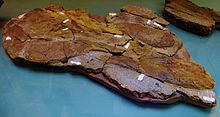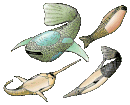Sacabambaspis
| Sacabambaspis Temporal range:
| |
|---|---|

| |
| Sacabambaspis fossil | |
| Scientific classification | |
| Domain: | Eukaryota |
| Kingdom: | Animalia |
| Phylum: | Chordata |
| Infraphylum: | Agnatha |
| Class: | †Pteraspidomorphi |
| Family: | † Sacabambaspidae
|
| Genus: | †Sacabambaspis Gagnier, Blieck & Rodrigo, 1986 |
| Type species | |
| †Sacabambaspis janvieri Gagnier, Blieck & Rodrigo, 1986
| |
| Species | |
| |
Sacabambaspis is an
Description
Sacabambaspis was approximately 25 cm (9+3⁄4 inches) in length. The body shape of Sacabambaspis vaguely resembled that of a tadpole with an oversized head, flat body, wriggling tail, and lack of fins. It had characteristic, frontally positioned eyes, like car
Armor
Sacabambaspis had a head shield made from a large upper (dorsal) plate that rose to a slight ridge in the midline and a deep curved lower (ventral) plate, this headshield is ornamented with characteristic oak-leaf shaped or tear-drop shaped tubercles.
Tail
The tail consists of relatively large dorsal and ventral webs and an elongated notochordal lobe, the posterior end of which is bordered by a small fin web. This tail structure clearly differs from that of
Discovery and species

Sacabambaspis is named after the village of Sacabamba, Cochabamba Department, Bolivia, where the first fossils of the genus were found.[6] S. janvieri (Gagnier, Blieck & Rodrico, 1986), the type species of the genus, is known from the Anzaldo Formation of Bolivia.[6] There are 30 known specimens of this Bolivian species, all crammed into a very confined area, believed to be the result of a fish kill, probably due a sudden inflow of freshwater from a large storm. They were found associated with a large number of lingulid brachiopods, also killed at the same time.[7]
Indeterminate specimens (described as "Sacabambaspis sp.") have been found in many countries corresponding to the margin of Gondwana. Young, 1997 described fossils of the genus from the Stokes Siltstone and Carmichael Sandstone of Central Australia.[8] Isolated scales found in the Horn Creek Siltstone from Central Australia have a very similar ornamentation to the Bolivian scales.[7] Specimens have also been reported from Argentina.[1] Sansom et al., 2009 described specimens from the Amdeh Formation of Oman on the Arabian Peninsula. The Oman discoveries showed that the fish were present all around the periphery of the ancient continent of Gondwana and not just in the southern regions as had previously been shown by the findings from South America and Australia.[1][9]
Paleobiology
Feeding
Although it had no jaws, the mouth of Sacabambaspis janvieri was lined with nearly 60 rows of small bony oral plates which were probably movable in order to provide more efficient suction-action through expansion and contraction of the oral cavity and pharynx.[7]
Sensory system
The fossils of Sacabambaspis show clear evidence of a sensory structure (lateral line system). This is a line of pores within each of which are open nerve endings that can detect slight movements in the water, produced for example by predators. The arrangement of these organs in regular lines allows the fish to detect the direction and distance from which a disturbance in the water is coming.[4]
In popular culture
In 2023, Sacabambaspis became a source of memes and fanarts after a viral tweet from August 2022 about a poorly reconstructed model of the Sacabambaspis from the Natural History Museum of Helsinki in Finland.[10]
See also
References
- ^ S2CID 128704925.
- ^ Janvier, Philippe (1997) Arandaspida The Tree of Life Web Project.
- ^ ISBN 978-1-4051-4449-0.
- ^ a b c Taylor & Francis (2001). PE Ahlberg (ed.) Major Events in Early Vertebrate Evolution. Sansom IJ, MM Smith & MP Smith. pp. 156–171.
- PMID 17443969.
- ^ ISSN 0016-6995.
- ^ a b c "Australia: The Land Where Time Began". Retrieved 28 October 2013.
- ISSN 0272-4634.
- ^ Miller, George (24 June 2011). "How can something that small appear on TV?". NaturePlus. Archived from the original on 7 October 2018. Retrieved 28 October 2013.
- ^ Amber V (16 June 2023). "470-million-year-old fish Sacabambaspis goes viral in Japan, Among Us dev joins in on fun". Automaton Media. Retrieved 8 February 2024.
External links
- Pteraspidomorphi at Palaeos








